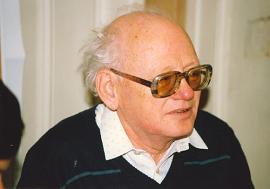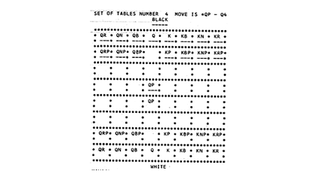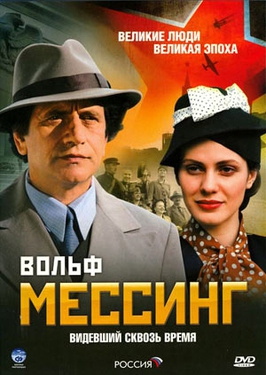
Vladimir L’vovich Arlazarov (Russian : Арлазаров Владимир Львович) is a Russian computer scientist born in Moscow.

Vladimir L’vovich Arlazarov (Russian : Арлазаров Владимир Львович) is a Russian computer scientist born in Moscow.
In 1965 at Alexander Kronrod's laboratory at the Moscow Institute for Theoretical and Experimental Physics (ITEP), Vladimir Arlazarov co-developed the ITEP Chess Program, together with Georgy Adelson-Velsky, Anatoly Uskov and Alexander Zhivotovsky, advised by Russian chess master Alexander Bitman and three-time world champion Mikhail Botvinnik.
At the end of 1966 a four game match began between the Kotok-McCarthy-Program, running on an IBM 7090 computer, and the ITEP Chess Program on a Soviet M-20 computer. The match played over nine months was won 3-1 by the ITEP program, despite playing on slower hardware.
By 1971, Mikhail Donskoy joined with Arlazarov and Uskov to program its successor on an ICL System 4/70 at the Institute of Control Sciences, called Kaissa, which became the first World Computer Chess Champion in 1974 in Stockholm.
Since 1977, Arlazarov has been the head of the System Programming Department at Institute of System Analysis, where he led the development of the INES database management system, for the creation and implementation of which he and his staff received an award from the USSR Council of Ministers. [1]
Arlazarov is one of the inventors of the Method of Four Russians.

The Institute for Theoretical and Experimental Physics is a multi-disciplinary research center located in Moscow, Russia. ITEP carries out research in the fields of theoretical and mathematical physics, astrophysics, high energy particle physics, nuclear physics, plasma physics, solid state physics, nanotechnology, reactor and accelerator physics, medical physics, and computer science. ITEP also maintains an extensive educational program and organizes physics schools for scholars and undergraduates. The institute is located near the corner of the Sevastopol prospect and the Nachimowski prospect and occupies part of the former estate "Cheryomushki-Znamenskoye" – an 18th-century manor that is a monument of architecture and landscape art of the 18th–19th centuries.

Georgy Maximovich Adelson-Velsky was a Soviet mathematician and computer scientist.

Aleksandr Semyonovich Kronrod was a Soviet mathematician and computer scientist, best known for the Gauss–Kronrod quadrature formula which he published in 1964. Earlier, he worked on computational solutions of problems emerging in theoretical physics. He is also known for his contributions to economics, specifically for proposing corrections and calculating price formation for the USSR. Later, Kronrod gave his fortune and life to medicine to care for terminal cancer patients. Kronrod is remembered for his captivating personality and was admired as a student, teacher and leader.
Alexeyev, Alekseyev, Alexeiev, Alexeev or Alekseev is a common Russian surname that is derived from the male given name Alexey (Алексей) and literally means Alexey's. Often the same name appears in English in several different transliterations. Similarly, Alexeyeva, Alekseyeva, Alexeeva and Alekseeva are female versions of the same last name.

Kotok-McCarthy also known as A Chess Playing Program for the IBM 7090 Computer was the first computer program to play chess convincingly. It is also remembered because it played in and lost the first chess match between two computer programs. A pseudocode of the program is in Figure 11.15 of.
Kaissa was a chess program developed in the Soviet Union in the 1960s. It was named so after Caissa, the goddess of chess. Kaissa became the first world computer chess champion in 1974 in Stockholm.

Alexander L'vovich Brudno was a Russian computer scientist, best known for fully describing the alpha-beta pruning algorithm. From 1991 until his death he lived in Israel.
Alexander Viktorovich Karzanov is a Russian mathematician known for his work in combinatorial optimization. He is the inventor of preflow-push based algorithms for the maximum flow problem, and the co-inventor of the Hopcroft–Karp–Karzanov algorithm for maximum matching in bipartite graphs. He is a chief researcher at the Federal Research Center "Computer Science and Control" of the Russian Academy of Sciences.
The leaders of the Russian Civil War listed below include the important political and military figures of the Russian Civil War. The conflict, fought largely from 7 November 1917 to 25 October 1922, was fought between numerous factions, the two largest being the Bolsheviks and the White Movement. While the Bolsheviks were centralized under the administration of the Russian Soviet Federative Socialist Republic and the Russian Communist Party (Bolsheviks), led by Vladimir Lenin, along with their various satellite and buffer states, the White Movement was more decentralized, functioning as a loose confederation of anti-Bolshevik forces united only in opposition to their common enemy - though from September 1918 to April 1920, the White Armies were nominally united under the administration of the Russian State, when, for nearly two years, Admiral Alexander Kolchak served as the overall head of the White Movement and as the internationally recognized Head of State of Russia. In addition to the two primary factions, the war also involved a number of third parties, including the anarchists of the Revolutionary Insurgent Army of Ukraine, and the non-ideological Green Armies.

Wolf Messing: Who Saw Through Time is a Russian TV series about fate of Wolf Messing, based on the novel of the same name by the screenwriter Eduard Volodarsky. by the Russia-1 TV channel. The series premiered on the Russia-1 on November 15, 2009.
At the beginning of the 1970s, video games existed almost entirely as novelties passed around by programmers and technicians with access to computers, primarily at research institutions and large companies. 1970 marked a crucial year in the transition of electronic games from academic to mainstream, with developments in chess artificial intelligence and in the concept of commercialized video games.
Yefim Dinitz is a Soviet and Israeli computer scientist associated with the Moscow school of polynomial-time algorithms. He invented Dinic's algorithm for computing maximal flow, and he was one of the inventors of the Four Russians' algorithm for multiplying Boolean or mod 2 matrices.
As of this edit, this article uses content from "chessprogramming - Vladimir Arlazarov" , which is licensed in a way that permits reuse under the Creative Commons Attribution-ShareAlike 3.0 Unported License, but not under the GFDL. All relevant terms must be followed.